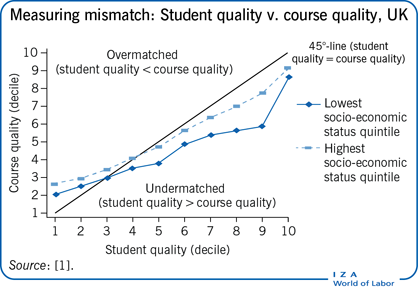Elevator pitch
A growing body of research has begun to examine the match between student ability and university quality. Initial research focused on overmatch—where students are lower attaining than their college peers. However, more recently, attention has turned to undermatch, where students attend institutions with lower attaining peers. Both have been shown to matter for student outcomes; while in theory overmatch could be desirable, there is evidence that overmatched students are less likely to graduate college. Undermatched students, meanwhile, have been shown to experience lower graduate earnings.
Key findings
Pros
Researchers have a good understanding of the characteristics of mismatched students, and the drivers of mismatch.
Mismatch is driven predominantly by student application behavior, rather than because well-matched colleges have rejected them.
Well designed and targeted information interventions have been shown to be effective in reducing undermatch by encouraging disadvantaged, academically able students to apply to, and enroll in, selective institutions.
Cons
Evidence suggests that overmatched students are less likely to graduate college.
Undermatched students are shown to experience lower graduate earnings.
Well-informed students have been found to overmatch more, i.e. they appear to prefer higher quality institutions even if they end up overmatching as a result.
Disadvantaged students are more likely to undermatch and less likely to overmatch.
There are significant research gaps on mismatch’s non-cognitive drivers, the relative importance of subject choice and student preferences, and impacts on future outcomes.
